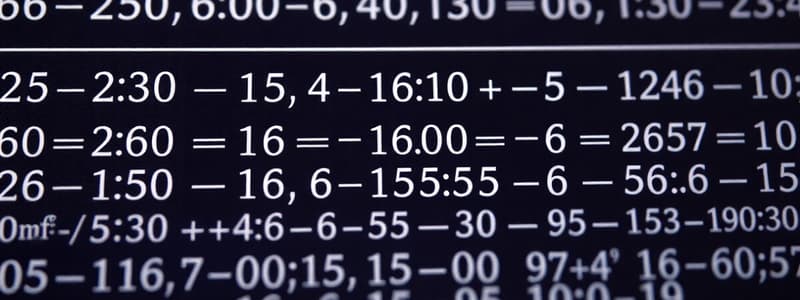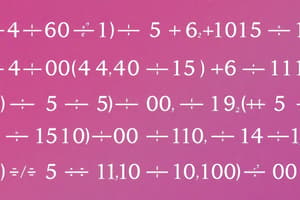Podcast
Questions and Answers
What is the common difference in the arithmetic sequence where the third term is 11 and the sixth term is 47?
What is the common difference in the arithmetic sequence where the third term is 11 and the sixth term is 47?
- 13
- 11
- 10
- 12 (correct)
The first term of the arithmetic sequence in Example 1 is 11.
The first term of the arithmetic sequence in Example 1 is 11.
False (B)
How many terms are there in the arithmetic sequence that starts with -38 and ends with 14?
How many terms are there in the arithmetic sequence that starts with -38 and ends with 14?
27
In the arithmetic sequence, the common difference d was found to be ____.
In the arithmetic sequence, the common difference d was found to be ____.
Match the following terms with their definitions:
Match the following terms with their definitions:
Flashcards
Common Difference (d)
Common Difference (d)
The difference between consecutive terms in an arithmetic sequence. It's the constant value added to each term to get the next one.
First Term (a)
First Term (a)
The first term in an arithmetic sequence. It's the starting point for the sequence.
General Formula (tₙ = a + (n-1)d)
General Formula (tₙ = a + (n-1)d)
The formula used to find any term in an arithmetic sequence. It involves the first term, the common difference, and the term number.
Number of Terms (n)
Number of Terms (n)
Signup and view all the flashcards
nth Term (tₙ)
nth Term (tₙ)
Signup and view all the flashcards
Study Notes
Arithmetic Sequence Formulas
- General Form: tn = a + (n-1)d
- tn = nth term
- a = first term
- n = term number
- d = common difference
Finding a and d
- Given t3 = 11 and t6 = 47:
- t3 = a + 2d = 11
- t6 = a + 5d = 47
- Subtracting the first equation from the second: 3d = 36, therefore d = 12
- Substituting d = 12 into the first equation: a + 2(12) = 11, therefore a = -13
Finding the number of terms
- Given the sequence -38, -36, ... , 14:
- a= -38, d = 2
- tn = 14
- 14 = -38 + (n - 1)(2)
- 52 = (n - 1)(2)
- 26 = n - 1
- n = 27
Studying That Suits You
Use AI to generate personalized quizzes and flashcards to suit your learning preferences.




